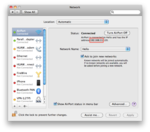Difference between revisions of "Installation/MacOSX"
| Line 4: | Line 4: | ||
= Installing from source = | = Installing from source = | ||
The tools that are required to work with paparazzi on a Mac are installed from MacPorts. | |||
If you already have MacPorts installed it is advised to run the following steps before proceeding. | |||
# sudo port selfupdate | |||
# sudo port upgrade outdated | |||
You can then run the installation steps below from step 3. | |||
If you don't already have MacPorts installed run the following steps | |||
# Install the latest XCode http://developer.apple.com/technologies/tools/xcode.html | # Install the latest XCode http://developer.apple.com/technologies/tools/xcode.html | ||
# Install MacPorts from http://www.macports.org/install.php | # Install MacPorts from http://www.macports.org/install.php | ||
| Line 14: | Line 22: | ||
If you want to follow the standard Paparazzi [[Git]] install then the prerequisite software can be installed by running the command <code>sudo port install paparazzi-tools</code> | If you want to follow the standard Paparazzi [[Git]] install then the prerequisite software can be installed by running the command <code>sudo port install paparazzi-tools</code> | ||
= Installation using the binary installer = | = Installation using the binary installer = | ||
Revision as of 17:22, 20 January 2011
The task of building Paparazzi on for Apple MacOS X is on going.
The current installation instructions are as follows. As the process evolves and the more people begin to use it the process will become easier and more simplified.
Installing from source
The tools that are required to work with paparazzi on a Mac are installed from MacPorts.
If you already have MacPorts installed it is advised to run the following steps before proceeding.
- sudo port selfupdate
- sudo port upgrade outdated
You can then run the installation steps below from step 3.
If you don't already have MacPorts installed run the following steps
- Install the latest XCode http://developer.apple.com/technologies/tools/xcode.html
- Install MacPorts from http://www.macports.org/install.php
- Install GIT
sudo port install git-core - Get a local copy of the Paparazzi Portability Support source
git clone git://github.com/paparazzi/paparazzi-portability-support.git - edit
/opt/local/etc/macports/sources.confand above thersync://...line addfile://<local path>/paparazzi-portability-support/darwin/macports/ports/ [nosync]for example:file:///Users/dummyuser/projects/paparazzi/paparazzi-portability-support/darwin/macports/ports/ [nosync]
- Install paparazzi
sudo port install paparazzi# then go and have lunch, get a coffee, get some sleep. this will probably take a long time - (TBD: I think this can be removed) edit ~/.profile or ~/.bash_profile and add export CPPFLAGS="-I/opt/local/include"
If you want to follow the standard Paparazzi Git install then the prerequisite software can be installed by running the command sudo port install paparazzi-tools
Installation using the binary installer
- Install the latest XCode http://developer.apple.com/technologies/tools/xcode.html
- Download the paparazzi binary installer from http://TODO find a place to host this file
- Install paparazzi by double clicking on the downloaded file paparazzi.mpkg
- edit /etc/profile and add export CPPFLAGS="-I/opt/local/include" (TODO: Remove the need for this)
If you want to follow the standard Paparazzi Git install then the prerequisite software can be installed by downloading the paparazzi-tools binary installer from http://TODO find a place to host this file and installing the tools by doublclicking on the downloaded file paparazzi-tools.mpkg
Configuration
Curently the Ivy bus library cannot utilse the standard loopback network interface on a Mac. If on ocassion you intend operate without a network (ie at the flying field) then set the environment variable IVY_BUS to the following multicast address thus:
export IVY_BUS=224.255.255.255
If the intent is to run the ground segment distributed across a number of computers the the IVY_BUS environment variable should be set to a local network address.
For example:
export IVY_BUS=192.168.1.255
Note that your network address is the network you are currently using. If you are at home configuring on a wireless network, that network won't be available out in the field. Thus in nearly every case
Alternatively the bus can be specified as arguments to each command in the GCS.
- Close all processes using the stop button
- add -b <network>.255 to each command
- start the processes again
Running Paparazzi
Paparazzi can be started in the usual way
cd ~/paparazzi ./paparazzi
Changing the gtk look and feel
Run /opt/local/bin/switch2 to select a different theme. More detailed instructions can be found at http://gtk.php.net/manual/en/html/tutorials/tutorials.installation.macosx-stepbystep.html
Additional themes can be downloaded from http://art.gnome.org/themes/gtk2
FTDI Drivers
FTDI drivers can be downloaded from FTDI
The device will probably become available as something like /dev/tty.usbserial-000013FD when connected. Note that different USB ports get different addresses. When connecting to another port the same device came up as /dev/tty.usbserial-000014FA
Since Paparazzi is currently configured to use /dev/ttyUSB0 it's easiest to just create a link to the required device.
- Remove all USB devices from the computer and run the command
ls -l /dev/*usb* /dev/*USB*hopefully this will not list anything - Plug in your radio and repeat the command
ls -l /dev/*usb* /dev/*USB*this should now list the serial port that the radio has been connected to. In my case I getls -l /dev/*usb* /dev/*USB*
- crw-rw-rw- 1 root wheel 11, 27 20 Jan 14:38 /dev/cu.usbserial-000013FD
- crw-rw-rw- 1 root wheel 11, 26 20 Jan 14:38 /dev/tty.usbserial-000013FD
- Next we need to create a symbolic link to the tty.usbserial device listed to /dev/ttyUSB0 in my case the command is
sudo ln -s /dev/tty.usbserial-000013FD /dev/ttyUSB0 - To check that everything is correct run the first command again
ls -l /dev/*usb* /dev/*USB*and you should get something like thisls -l /dev/*usb* /dev/*USB*
- crw-rw-rw- 1 root wheel 11, 27 20 Jan 14:38 /dev/cu.usbserial-000013FD
- crw-rw-rw- 1 root wheel 11, 26 20 Jan 14:38 /dev/tty.usbserial-000013FD
- lrwxr-xr-x 1 root wheel 0 20 Jan 14:42 /dev/ttyUSB0 -> /dev/tty.usbserial-000013FD

